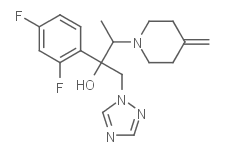
Efinaconazole
CAS No. 164650-44-6
Efinaconazole( KP103 | KP-103 | CTK5J2975 | AGJ95634 | Efinaconazole )
Catalog No. M17358 CAS No. 164650-44-6
Efinaconazole(KP-103) is an Azole Antifungal currently under development as a topical treatment for onychomycosis.
Purity : >98% (HPLC)
 COA
COA
 Datasheet
Datasheet
 HNMR
HNMR
 HPLC
HPLC
 MSDS
MSDS
 Handing Instructions
Handing Instructions
| Size | Price / USD | Stock | Quantity |
| 5MG | 39 | In Stock |


|
| 10MG | 55 | In Stock |


|
| 25MG | 95 | In Stock |


|
| 50MG | 152 | In Stock |


|
| 100MG | 235 | In Stock |


|
| 500MG | 579 | In Stock |


|
| 1G | Get Quote | In Stock |


|
Biological Information
-
Product NameEfinaconazole
-
NoteResearch use only, not for human use.
-
Brief DescriptionEfinaconazole(KP-103) is an Azole Antifungal currently under development as a topical treatment for onychomycosis.
-
DescriptionEfinaconazole is a triazole antifungal. It is approved for use in Canada and the USA as a 10% topical solution for the treatment of onychomycosis (fungal infection of the nail). Efinaconazole acts as a 14α-demethylase inhibitor. Efinaconazole inhibits fungal lanosterol 14α-demethylase involved in the biosynthesis of ergosterol, a constituent of fungal cell membranes. Efinaconazole has been shown to be active against isolates of the following microorganisms, both in vitro and in clinical infections. Efinaconazole exhibits in vitro minimum inhibitory concentrations (MICs) of 0.06 μg/mL or less against most ( ≥ 90%) isolates of the following microorganisms: Trichophyton rubrum; Trichophyton mentagrophytes.(In Vivo):Topical Efinaconazole solution (0.25 to 1%) is dose-dependently effective in treating both dermatophytoses, for 10 guinea pigs with interdigital tinea pedis or tinea corporis is investigated. The follow up study performs on day-30 and day-9 posttreatment demonstrated that the relapse rates for 1% Efinaconazole-treated animals with tinea pedis and for those with tinea corporis are 20 and 30%, respectively. When a single dose of 1% Efinaconazole is applied to the back skin 48 hours before fungal inoculation, 9 of the 10 animals are protected from the dermatophytosis, suggesting that active Efinaconazole is retained in skin tissue for at least 48 hours after dosing.
-
In Vitro——
-
In VivoTopical Efinaconazole solution (0.25 to 1%) is dose-dependently effective in treating both dermatophytoses, for 10 guinea pigs with interdigital tinea pedis or tinea corporis is investigated. The follow up study performs on day-30 and day-9 posttreatment demonstrated that the relapse rates for 1% Efinaconazole-treated animals with tinea pedis and for those with tinea corporis are 20 and 30%, respectively. When a single dose of 1% Efinaconazole is applied to the back skin 48 hours before fungal inoculation, 9 of the 10 animals are protected from the dermatophytosis, suggesting that active Efinaconazole is retained in skin tissue for at least 48 hours after dosing.
-
SynonymsKP103 | KP-103 | CTK5J2975 | AGJ95634 | Efinaconazole
-
PathwayAngiogenesis
-
TargetPDGFR
-
RecptorAntifungle
-
Research AreaInfection
-
Indication——
Chemical Information
-
CAS Number164650-44-6
-
Formula Weight348.34
-
Molecular FormulaC18H22F2N4O
-
Purity>98% (HPLC)
-
SolubilityDMSO : ≥ 100 mg/mL;287.03 mM
-
SMILESC=C1CCN(CC1)[C@@H]([C@@](c1ccc(cc1F)F)(Cn1cncn1)O)C
-
Chemical Name(2R,3R)-2-(2,4-difluorophenyl)-3-(4-methylenepiperidin-1-yl)-1-(1H-1,2,4-triazol-1-yl)butan-2-ol
Shipping & Storage Information
-
Storage(-20℃)
-
ShippingWith Ice Pack
-
Stability≥ 2 years
Reference
1. Tatsumi Y, et al. Antimicrob Agents ChemOthers. 2013 May;57(5):2405-9.
molnova catalog



related products
-
N-(p-Coumaroyl) sero...
N-(p-Coumaroyl) Serotonin is a polyphenol isolated from the seeds of safflower.?N-(p-Coumaroyl) serotonin has antioxidant, cardioprotective effects after ischemia and antitumor activity, it may be beneficial in improving vascular distensibility and in reducing cardiovascular risk.
-
TSU-68
TSU-68 (Orantinib, SU6668) is a small-molecule, ATP-competitiv inhibitor of angiogenic related RTKs KDR, PDGFRβ, FGFR1.
-
AG-1295
A quinoxaline-type tyrphostin that acts as a potent and selective inhibitor of PDGFR kinase in vitro and in Swiss 3T3 cells with IC50 of 0.3-1 uM.



 Cart
Cart
 sales@molnova.com
sales@molnova.com


